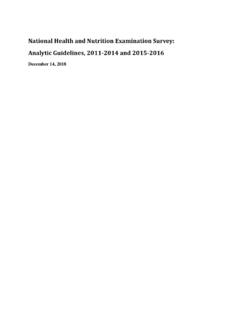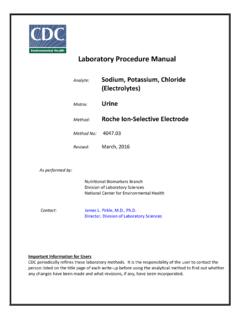Transcription of Laboratory Procedure Manual - Centers for Disease Control ...
1 Laboratory Procedure Manual Analyte: Fasting Glucose Matrix: Plasma Method: Roche cobas C311 2017 Standard As performed by: University of Missouri-Columbia Contact: Dr. Randie Little Important Information for Users The University of Missouri periodically refines these Laboratory methods. It is the responsibility of the user to contact the person listed on the title page of each write-up before using the analytical method to find out whether any changes have been made and what revisions, if any, have been incorporated. Public Release Data Set Information This document details the Lab Protocol for testing the items listed in the following table: File Name Variable Name SAS Label (and SI units) GLU_I OGTT_I LBXGLU Fasting glucose(mg/dL) LBDGLUSI Fasting glucose (mmol/L) LBXGLT Two-hour glucose (OGTT) (mg/dL) LBDGLTSI Two-hour glucose (OGTT) (mmol/L) Fasting Glucose NHANES 2015-20162 of 22 I.
2 Purpose Statement a. This SOP is intended for the in vitro test for the quantitative determination of glucose in human serum and plasma. It is performed on the Roche cobas C311 system in the Diabetes Diagnostic Laboratory . II. Definitions a. Not Applicable III. Content a. Principle and Clinical Significance Glucose is the major carbohydrate present in the peripheral blood. Glucose derived from dietary sources is either oxidized to provide energy or converted to glycogen or fatty acids for storage in the liver and tissues. The most frequent cause of hyperglycemia is diabetes mellitus. Some other factors that contribute to elevated blood glucose are pancreatitis, pituitary or thyroid dysfunction, renal failure, and liver Disease . Hypoglycemia is less frequently observed, but is found in conditions such as insulinoma, hypopituitarism, neoplasms, or insulin-induced hypoglycemia1,2,3,4. The cobas c311 performs a UV test to detect glucose in blood serum and plasma.
3 The enzyme hexokinase (HK) catalyzes the reaction between glucose and adenosine triphosphate (ATP) to form glucose-6-phosphate (G-6-P) and adenosine diphosphate (ADP). In the presence of nicotinamide adenine dinucleotide (NAD), G-6-P is oxidized by the enzyme glucose-6-phosphate dehydrogenase (G-6-PD) to 6-phosphogluconate and reduced nicotinamide adenine dinucleotide (NADH). The increase in NADH concentration is directly proportional to the glucose concentration and can be measured spectrophotometrically at 340 nm. G-6-P + NADP+ G-6-PDH gluconate-6-P + NADPH + H+ Fasting Glucose NHANES 2015-20163 of 22 The enzymatic reference method is performed with Hexokinase catalyzes the phosphorylation of glucose to glucose-6-phosphate by ATP. b. Specimen Collection and Handling i. Patient Preparation 1. Patients should be fasting or undergoing an Oral Glucose Tolerance Test. Patient s status should be recorded when specimen is drawn. ii. Specimen Type 1.
4 Collect blood by venipuncture from individuals using an evacuated tube system a. Plasma: Fluoride plasma for NHANES study testing (grey top tubes) 2. The minimum volume required for analysis directly from collection tube is 200 L. 3. Specimens are delivered to the Diabetes Diagnostic Laboratory , Room M764 by FedEx. Specimens are received frozen on dry ice and are stored at -70oC. Each specimen must arrive in the Laboratory labeled with two unique accession number generated by NHANES, and checked against the specimen manifest. iii. Specimen Stability 1. Stability in fluoride plasma:5 3 days at 15-25 C At least 3 months @ -20 C At least 2 years @-70 C 2. Unacceptable specimen criteria a. Clotted specimens. Glucose + ATP HK G-6-P + ADP Fasting Glucose NHANES 2015-20164 of 22b. Unlabeled samples c. Specimens not collected in sodium fluoride. d. Whole blood specimens e. Refer to limitations section for additional details f. The below must be followed for unaccepted specimen collections: i.
5 Record all unacceptable samples on sample manifest ii. Contact NHANES regarding unacceptable specimen iv. Handling Conditions 1. For specimen collection and preparation, only use suitable tubes or collection containers. Only the specimens listed below were tested and found acceptable: Plasma: fluoride plasma for NHANES study testing. (Grey-top tubes) 2. To minimize glycolysis, one should place the sample tube immediately in an ice-water slurry, and the plasma should be separated from the cells within 30 min. Blood for FPG analysis should be drawn in the morning after the individual has fasted overnight (at least 8 hours). 3. If testing is not performed immediately, samples are to be maintained under frozen conditions (-70 C). 4. For NHANES samples: Laboratory services are requested through the Westat system operations via an email notification containing a unique manifest list of the samples and sample analysis type ( Glucose), which confirms that specimens have been shipped to DDL.
6 Transport under frozen conditions. 5. Each Manifest Form should include and verified against each sample received: a. Patient Sample ID # b. Test Name c. Date Collected d. Shipment ID # e. Shipment Date f. Lab Name g. Lab ID h. Survey Year 6. Once received and prepared for analysis, specimens are to be immediately returned to -70 C storage. When ready to be analyzed, specimens are to be thawed at room temperature. Fasting Glucose NHANES 2015-20165 of 22 Following testing, specimens are to be returned to -70 C for long-term storage. c. Equipment and Materials i. Equipment 1. Roche cobas C311 analyzer consists of the following main components: a. analyzer Unit i. Sample disk: 110 position disk for loading of up to 108 samples ii. Sample detectors and barcode readers: on inner and outer rings iii. Sample Pipetting System: clot detecting by pressure measurements, liquid level detection by capacitance, and abnormal descent detection. 1. Metal shield pipe 2.
7 Rinse station 3. Drying cylinder 4. Basic (sample cleaner 1) and acid wash (sample cleaner 2) solutions for special probe washes and maintenance functions. iv. Reagent Compartment v. Reagent Pipetting System vi. Reaction Disk Area vii. ISE System (not in use) viii. Water supply tank ix. Vacuum System x. Sound Volume Knob xi. Cell Wash Solutions xii. Waste Container xiii. Inlet Water Line xiv. Dilute Waste Line b. Control Unit i. Computer 1. Hard Disk Drive 2. 3- 1/2 in floppy disk drive and a DVD-RW rewrite device ii. Keyboard iii. Mouse iv. Color Monitor: touch screen v. Printer Fasting Glucose NHANES 2015-20166 of 22ii. Materials 1. Reagents and other items a. R1: MES buffer: mmol/L, pH ; Mg2+: 24 mmol/L; ATP: mmol/L; NADP: mmol/L; preservative b. R2: HEPES buffer: 200 mmol/L, pH ; Mg2+: 4 mmol/L; HK (yeast): 300 kat/L; G-6-PDH (E. coli): 300 kat/L; preservative c. Sample vials and false bottom tubes d. Printer paper. e. Toner cartridge.
8 F. Refer to MSDS located in the Operator s Manual for reagent description and composition 2. Other materials a. Powder free hypoallergenic latex examination gloves. b. Biohazardous waste storage bags and boxes (Jefferson Smufit Corporation, Highland, IL). c. Viro Research Envirocide Disinfectant Decontaminant Cleaner (Fisher Scientific, St. Louis, MO) d. Transfer pipettes (Fisher Scientific, St. Louis, MO) e. Single fold paper towels (Ft. Howard Corp. Co, Green Bay, WI). f. Kim Wipe lintless tissues (Kimberly Clark Corp., Roswell, GA). g. Low and high in-house plasma controls (low and high, respectively). h. Bio-Rad controls i. Volumetric pipettes for measuring different volumes. iii. Equipment Maintenance 1. Roche cobas c311 Routine maintenance a. Perform daily maintenance as outlined in cobas c311 Manual every time machine is used b. Perform weekly maintenance as outlined in cobas c311 Manual once a week (generally whenever machine is used) c. Perform monthly, quarterly and bi-annually maintenance when assigned 2.
9 Record all daily, weekly, monthly, and periodical maintenance in the C311 Maintenance binder. This paperwork is approved by the supervisor monthly and filed in C311 Maintenance binder. 3. Roche Periodic/Preventative maintenance Preventative maintenance inspections will be done at least yearly. 4. Pipettes are to be calibrated once a year. Fasting Glucose NHANES 2015-20167 of 225. Temperatures for the refrigerators and freezers where specimens, controls and calibrators are stored are to be recorded. Any readings that fall outside acceptable ranges are to be reported to the supervisor for corrective action. These areas are monitored by 7 day 24 hour temperature recorders for minimum and maximum temperatures and are checked daily (working day) by a technician to make sure the temperatures are within acceptable ranges. The charts are to be checked and initialed by the supervisor at least weekly. iv. Storage Requirements Reagent Use and Storage: 1.
10 GLUC3 a. Shelf life at 2-8 C: see expiration date on cobas c pack label b. On-board, in use and refrigerated on the analyzer : 8 weeks 2. Diluent NaCl 9 % a. Shelf life at 2-8 C: see expiration date on cobas c pack label b. On-board, in use and refrigerated on the analyzer : 12 weeks 3. All regents are ready for use; to load packs onto machine, follow instructions in cobas c311 analyzer Basic Operator Training Guide. v. Reagent Labeling: Reagents, calibrators, controls, and solutions should be traceably identified to indicate the following: 1. Content and quantity, concentration or titer 2. Storage requirements. 3. Date 4. The below should be followed for reagents used daily a. Preparation date or opened and the identity of the preparer; b. Tech s initials 5. When new reagents are received they must be initialed and dated by the technician who receives them. When the reagents are opened they are initialed and dated with open date by the technician. a.









